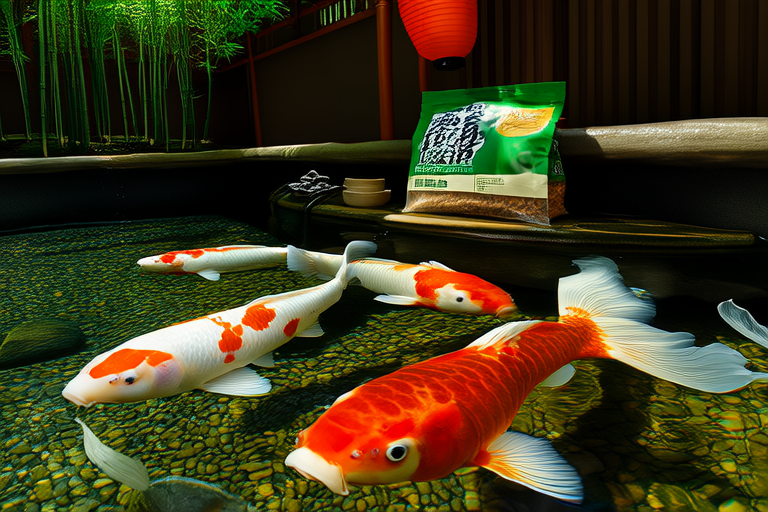The Ultimate Guide to Feeding and Caring for Koi
Keeping koi fish can be an incredibly rewarding experience, offering both visual enjoyment and a sense of accomplishment. However, it comes with significant responsibilities, especially when it comes to their diet and overall care. This comprehensive guide will cover all aspects of koi feeding and care, from understanding their dietary needs to maintaining a healthy pond environment.
Optimal Feeding Practices
Koi require a balanced diet rich in protein, carbohydrates, fats, vitamins, and minerals to thrive. Their nutritional needs vary based on age, size, and the time of year. Young koi need more protein (up to 40%) than adult koi, which generally require around 30% protein. The rest of their diet should consist of carbohydrates, fats, and other nutrients.
Commercial koi food is available in various forms, including flakes, pellets, sticks, and granules. Choose food that matches your koi’s size and age. Smaller koi may need smaller-sized food, while larger koi can handle bigger pieces. Additionally, consider the water temperature when feeding; koi are less active and eat less when the water is cold.
Dietary Requirements
Protein is crucial for growth and repair, particularly for young koi. Carbohydrates provide energy, and fats help maintain body condition. Vitamins and minerals support overall health. A high-quality koi food should include these components. Some specialized diets also contain probiotics, which promote beneficial gut bacteria.
Frequency and Quantity of Feed
The frequency and quantity of feed depend on the number of fish, their size, and the water temperature. As a general rule, feed koi twice daily during warmer months and reduce feedings to once per day or even less in colder temperatures. Feed only what the koi can consume within five minutes to avoid overfeeding, which can lead to water pollution.
Types of Food Suitable for Different Seasons
In spring and summer, koi are more active and require more frequent feedings. Use high-protein foods to support growth. In autumn, gradually reduce the amount and frequency of feedings as water temperatures decrease. During winter, when koi are less active, feeding may not be necessary unless the water remains above 50°F (10°C).
Essential Care Tips
Water Quality Maintenance
Maintaining good water quality is crucial for koi health. Regularly test the water parameters, including pH, ammonia, nitrite, and nitrate levels. Keep the pH between 7.2 and 8.0 and ensure that ammonia and nitrite levels remain at zero. Nitrate levels should be kept below 50 ppm.
Use biological filtration systems to break down harmful compounds and maintain a stable ecosystem. Regular water changes, typically 10-20% every two weeks, help dilute toxins and replenish essential minerals.
Pond Management
Proper pond management includes regular cleaning and maintenance. Remove debris such as leaves and algae to prevent clogging filters and reducing oxygen levels. Consider installing a skimmer to trap floating debris before it sinks to the bottom of the pond.
Ensure adequate oxygenation by using air pumps and diffusers. Koi require at least 2-3 ppm of dissolved oxygen, and this requirement increases in warmer weather.
Disease Prevention
Prevention is key to avoiding diseases. Maintain a clean environment, quarantine new fish, and avoid overcrowding. Regularly check your koi for signs of illness, such as abnormal behavior, lesions, or white spots. Early detection and treatment are crucial for successful recovery.
Some common diseases include ich, fin rot, and bacterial infections. Consult a veterinarian specializing in aquatic animals for diagnosis and treatment options.
Common Health Issues
Ich is a parasitic infection causing small white spots on the skin and gills. Fin rot results in frayed or disintegrating fins due to bacterial or fungal infections. Bacterial infections can cause ulcers, redness, and lethargy. Each condition requires specific treatments, so consult a professional if you suspect any issues.
Selecting Appropriate Pond Environments and Equipment
Pond Size and Depth
Adequate pond size and depth are vital for koi health. Each koi should have approximately 200-300 gallons of water. Deeper ponds (at least 4 feet) provide better insulation against temperature fluctuations and offer hiding places for koi.
Consider the location of the pond, ensuring it receives partial sunlight but avoids direct exposure to harsh midday sun. Shaded areas can be created using plants or artificial structures.
Filtration Systems
An efficient filtration system is essential for maintaining water quality. Mechanical filters remove large particles, biological filters convert harmful chemicals into less toxic substances, and chemical filters absorb dissolved pollutants. Choose a filtration system based on the pond’s volume and the number of fish.
Oxygenation Equipment
Ensure sufficient oxygenation through the use of air pumps, diffusers, and waterfalls. These devices increase surface agitation, promoting gas exchange and preventing stagnation.
Heating and Cooling Solutions
In regions with extreme temperatures, consider heating or cooling solutions to maintain a stable environment. Heating pads or underwater heaters can be used in cold climates, while shading and aeration help in hot weather.
Conclusion
Feeding and caring for koi require attention to detail and commitment. By following the guidelines outlined in this ultimate guide, you can provide your koi with a healthy, thriving environment. Remember that each pond and its inhabitants are unique, so adapt your approach based on individual needs and circumstances.
